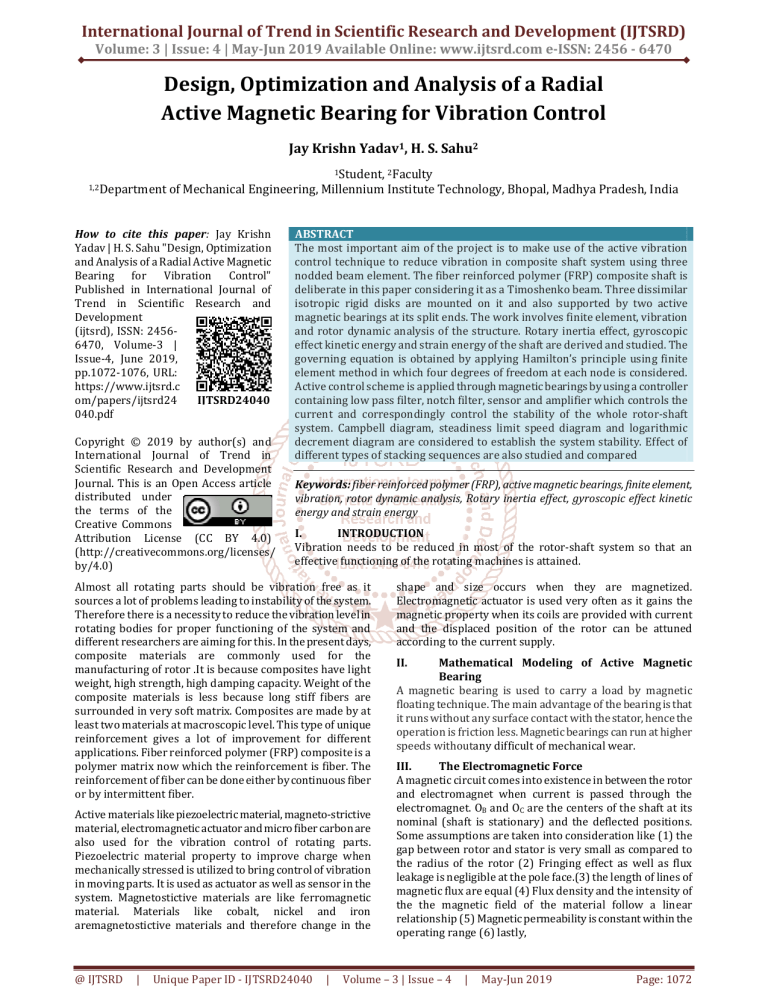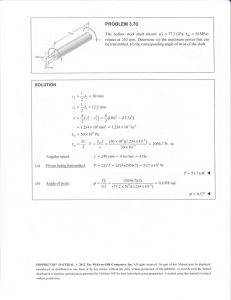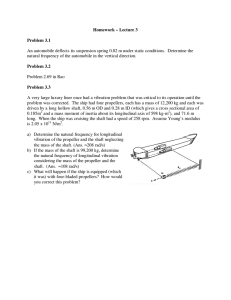
International Journal of Trend in Scientific Research and Development (IJTSRD)
Volume: 3 | Issue: 4 | May-Jun 2019 Available Online: www.ijtsrd.com e-ISSN: 2456 - 6470
Design, Optimization and Analysis of a Radial
Active Magnetic Bearing for Vibration Control
Jay Krishn Yadav1, H. S. Sahu2
1Student, 2Faculty
1,2Department
of Mechanical Engineering, Millennium Institute Technology, Bhopal, Madhya Pradesh, India
How to cite this paper: Jay Krishn
Yadav | H. S. Sahu "Design, Optimization
and Analysis of a Radial Active Magnetic
Bearing for Vibration Control"
Published in International Journal of
Trend in Scientific Research and
Development
(ijtsrd), ISSN: 24566470, Volume-3 |
Issue-4, June 2019,
pp.1072-1076, URL:
https://www.ijtsrd.c
om/papers/ijtsrd24
IJTSRD24040
040.pdf
Copyright © 2019 by author(s) and
International Journal of Trend in
Scientific Research and Development
Journal. This is an Open Access article
distributed under
the terms of the
Creative Commons
Attribution License (CC BY 4.0)
(http://creativecommons.org/licenses/
by/4.0)
ABSTRACT
The most important aim of the project is to make use of the active vibration
control technique to reduce vibration in composite shaft system using three
nodded beam element. The fiber reinforced polymer (FRP) composite shaft is
deliberate in this paper considering it as a Timoshenko beam. Three dissimilar
isotropic rigid disks are mounted on it and also supported by two active
magnetic bearings at its split ends. The work involves finite element, vibration
and rotor dynamic analysis of the structure. Rotary inertia effect, gyroscopic
effect kinetic energy and strain energy of the shaft are derived and studied. The
governing equation is obtained by applying Hamilton’s principle using finite
element method in which four degrees of freedom at each node is considered.
Active control scheme is applied through magnetic bearings by using a controller
containing low pass filter, notch filter, sensor and amplifier which controls the
current and correspondingly control the stability of the whole rotor-shaft
system. Campbell diagram, steadiness limit speed diagram and logarithmic
decrement diagram are considered to establish the system stability. Effect of
different types of stacking sequences are also studied and compared
Keywords: fiber reinforced polymer (FRP), active magnetic bearings, finite element,
vibration, rotor dynamic analysis, Rotary inertia effect, gyroscopic effect kinetic
energy and strain energy
I.
INTRODUCTION
Vibration needs to be reduced in most of the rotor-shaft system so that an
effective functioning of the rotating machines is attained.
Almost all rotating parts should be vibration free as it
sources a lot of problems leading to instability of the system.
Therefore there is a necessity to reduce the vibration level in
rotating bodies for proper functioning of the system and
different researchers are aiming for this. In the present days,
composite materials are commonly used for the
manufacturing of rotor .It is because composites have light
weight, high strength, high damping capacity. Weight of the
composite materials is less because long stiff fibers are
surrounded in very soft matrix. Composites are made by at
least two materials at macroscopic level. This type of unique
reinforcement gives a lot of improvement for different
applications. Fiber reinforced polymer (FRP) composite is a
polymer matrix now which the reinforcement is fiber. The
reinforcement of fiber can be done either by continuous fiber
or by intermittent fiber.
Active materials like piezoelectric material, magneto-strictive
material, electromagnetic actuator and micro fiber carbon are
also used for the vibration control of rotating parts.
Piezoelectric material property to improve charge when
mechanically stressed is utilized to bring control of vibration
in moving parts. It is used as actuator as well as sensor in the
system. Magnetostictive materials are like ferromagnetic
material. Materials like cobalt, nickel and iron
aremagnetostictive materials and therefore change in the
@ IJTSRD
|
Unique Paper ID - IJTSRD24040
|
shape and size occurs when they are magnetized.
Electromagnetic actuator is used very often as it gains the
magnetic property when its coils are provided with current
and the displaced position of the rotor can be attuned
according to the current supply.
II.
Mathematical Modeling of Active Magnetic
Bearing
A magnetic bearing is used to carry a load by magnetic
floating technique. The main advantage of the bearing is that
it runs without any surface contact with the stator, hence the
operation is friction less. Magnetic bearings can run at higher
speeds withoutany difficult of mechanical wear.
III.
The Electromagnetic Force
A magnetic circuit comes into existence in between the rotor
and electromagnet when current is passed through the
electromagnet. OB and OC are the centers of the shaft at its
nominal (shaft is stationary) and the deflected positions.
Some assumptions are taken into consideration like (1) the
gap between rotor and stator is very small as compared to
the radius of the rotor (2) Fringing effect as well as flux
leakage is negligible at the pole face.(3) the length of lines of
magnetic flux are equal (4) Flux density and the intensity of
the the magnetic field of the material follow a linear
relationship (5) Magnetic permeability is constant within the
operating range (6) lastly,
Volume – 3 | Issue – 4
|
May-Jun 2019
Page: 1072
International Journal of Trend in Scientific Research and Development (IJTSRD) @ www.ijtsrd.com eISSN: 2456-6470
IV.
Mathematical Modeling of Controller
A controller is used here for the active control of the FRP
rotor shaft system. In the controller there are several actions
take place that should be taken under consideration for
proper modeling of the system and to get an appropriate
transfer function. One bearing consists of four pairs of
electromagnetic pole which are placed around the periphery
of the rotor in a symmetric way. Only two control axes along
Y and Z direction are considered for the control purpose.
Figure (3) is showing a block diagram for a radial dynamic
magnetic bearing with the controller and other electronic
devices like sensor and amplifier. There are changed types of
operations take place within the controller to achieve a
proper control of magnetic bearing stability.
Results and Discussions
V.
The rotor with AMB, used for the numerical simulation is
shown in the figure (5.1). A complete programming is
developed using MATLAB 13a to analyze the effectiveness of
active control method on the stability of the FRP rotor shaft
system. The shaft is loaded with three dishes and is
supported with the help of two identical orthotropic bearings.
7
= 1.75×10 N/m, s/m, czz= 500 N s/m.
bearingarek
The reference signal is set to zero in the AMB system to align
the rotor within the axes of the rotor. Hence this particular
input feed can be discounted in the controller function. The
director used here is a digital electronic device. Therefore
the position signal coming out from the differential sensor in
the voltage form is required to be changed into digital form
before sending it to the system controller. An analog to
digital converter is used for taken as 2a=45.
shown in the Fig.1 Controller is connected with the bearing
and offers active vibration and stability control of the whole
system. Bias current for each of the magnets within the
magnetic bearing is 0.75this purpose. The process of
digitization does not affect the overall control of the system,
therefore it is ignored. A simplified one, neglecting the open
loop control, signal injection, analog-digital converter and
digital-analog converter which are discussed above. The
signal taken as a orientation is first set to a zero value.
Therefore this system input is ignored and the position input
is taken in consideration as well. The stiffness and damping
coefficient can be determined from the feed through transfer
function, G(s), which is discussed above in the section. Hence
a simplified block diagram to find out axis stiffness and
damping coefficient values.
Fig. 1. Block diagram showing the closed loop control
for single axis AMB.
Amps which more closely mimics a power-limited
system. A nominal gap of 0.381 mm is maintained
initially when no vibration takes place. A low pass filter
with a cutoff frequency of 800 Hz and a damping ratio
of 0.7 is used along with a PID filter with very low gains
to initially levitate the system .A notch filter is also
used to dampen out high frequency resonance. It is used
at a frequency of 200 Hz which is substantially higher than
the first critical speed of the controlled system.
Table.1 Parameters of FRP composite shaft system
Parameter
Shaft
Disk1
Length
1.2
Diameter (mm)
100
Density
Coefficient of viscous damping
Coefficint of hysteretic damping
Eccentricity (m)
Shear correction factor
Mass of disc(kg)
1578
0.0002
0.0002
Longitudinal Young’s Modulus (GPa)
Transverse Young’s Modulus (GPa)
Poisson’sRatio 0.313
139
Disk 2
Disk 3
0.0002
0.0002
0.0002
45.947
45.947
45.947
0.56
11
0.313
VI.
Comparison Between Controlled and Uncontrolled Responses
The comparisons between the controlled and uncontrolled responses of the FRP composite shaft system are clearly shown in the
Fig.2, Fig.3. and Fig.4.These results are obtained by using the stacking sequence[90/45/45/0/0/0/0/0/90].
In the uncontrolled response of the FRP composite shaft system, the bearing stiffness and damping is present along with internal
viscous and hysteretic damping of the shafts. On the other hand in the uncontrolled response, additional stiffness and damping
values are added to the system in an active way with the use of an active controller discussed earlier.
The Campbell diagram shown in the Fig.2 clearly exhibits that the critical speed of the uncontrolled shaft system is around 3045
rpm, which is increased up to 3814 rpm when active control technique is applied.
@ IJTSRD
|
Unique Paper ID - IJTSRD24040
|
Volume – 3 | Issue – 4
|
May-Jun 2019
Page: 1073
International Journal of Trend in Scientific Research and Development (IJTSRD) @ www.ijtsrd.com eISSN: 2456-6470
Figure 3 shows the variation of damping ratio of the controlled and uncontrolled rotor- bearing system. Six natural modes are
being shown where we see that the damping ratio in the uncontrolled case becomes negative around 13600 rpm.
Figure 4 shows the same fact that the stability limit speed can reach up to 13580 rpm with active control system in place.
Fig.2. Comparison of the controlled system fig.2. (a)and fig.2. (b.) Campbell diagram for uncontrolled system.
Fig.3.Variation of damping ratio of first six modes for controlledfig 3(a.)system and fig 3(b.). uncontrolled system.
@ IJTSRD
|
Unique Paper ID - IJTSRD24040
|
Volume – 3 | Issue – 4
|
May-Jun 2019
Page: 1074
International Journal of Trend in Scientific Research and Development (IJTSRD) @ www.ijtsrd.com eISSN: 2456-6470
Effect of Stacking Sequences
In Table No.2 different stacking sequences are taken under consideration. In symmetric stacking sequence the stability limit
value changes from 2535 rpm to 2627 rpm when active magnetic bearing control is applied. The first critical speed also
variations its value from 2405 rpm to 2765 rpm.
In anti-symmetric stacking sequence the critical
Fig.4.Variation of maximun real part of the eigenvalueswith rotational speed
Hence it does not affect the stability of the system.
Uncontrolled
Controlled
Stability Limit
Critical Speed
Critical Speed
Speed (Rpm)
(Rpm)
(Rpm)
[90/90/45/0/0]S
2405
2535
2765
[45/0/45/0/90]AS
2731
3192
3250
[0/90/0/90/0/90/0/90/0/90]
2630
8651
3112
[90/45/45/0/0/0/0/0/0/9]
3045
11260
3814
Table No.5.2Comparison of different stacking
Stacking Sequence
Stability Limit
Speed(Rpm)
2627
3655
9908
13580
speed value increases to 3250 rpm from 2731 rpm while stability limit speed increase to 3655 rpm from 3192 rpm.
In the cross sequencing the critical speed variations from 2630 rpm to 3112 rpm. On the other hand stability limit speed rises
from 8651 rpm to 9908 rpm. For the stacking sequence of [90/45/45/0/0/0/0/0/0/90] the controlled response of the FRP
composite shaft system is also shown in the table. The critical speed in this case increases from 3045 rpm to 3814 rpm and
stability limit speed from 11260 rpm to 13545 rpm.
VII.
Conclusion
From the above results it may be concluded that the active
magnetic bearing used in the rotor-shaft system where rotor
is made up of fiber reinforced polymer (FRP) composite,
brings the system into a stable position. The active technique
is achieved by bringing a controller into the picture which
senses the displacement and controls the corresponding
current in order to achieve stability.
VIII.
Scope of Future Work
Functionally graded materials (FGM) can be used in
place of composite material for the shaft.
The effect of temperature can also be analyzed to see the
variation of the results with respect to different
temperature distribution.
The effect of stresses induced in the lamina of the
composite shaft can also be analyzed.
The different parameters of PID filter are tuned manually to
get the optimum results. The Campbell diagrams prove that
the critical speed of the controlled system has been increased
to a higher value and the stability limit speed (SLS) diagrams
show that the system can run at much superior speed when
operate with active control method. The active magnetic
bearing also provide a contact-free procedure which reduce
References
[1] GauravKumar,“Design and Analysis of a Radial Active
Magnetic Bearing for Vibration”, vol. 175(6), (2016).
rotor vibration. The control action is free from the problem of
maintenance, wear and tear and power loss due to friction.
@ IJTSRD
|
Unique Paper ID - IJTSRD24040
|
[2] Singh.S.P.,Gupta.K. “Composite Shaft Rotordynamic
analysis using a layerwise theory”, Journal of Sound
and Vibration, vol. 191(5), pp. 739-756,(2016).
[3] Kim.W.,Argento.A., and Scott.R.A “Free Vibration of a
Rotating Tapered Composite Shaft System”, Journal of
Sound and Vibration, vol. 226(1), pp. 125-147,(2015).
Volume – 3 | Issue – 4
|
May-Jun 2019
Page: 1075
International Journal of Trend in Scientific Research and Development (IJTSRD) @ www.ijtsrd.com eISSN: 2456-6470
[4] Chang.M.Y.,Chen.J.K., and Chang.C.Y. “A simple Spinning
Laminated Composite Shaft Model”, International
Journal of Solids and Structures, vol. 41, pp. 637662,(2015).
[5] Ghoneam.S.M.,Hamada.A.A.,
and
El-Elamy.M.I.
“Dynamic Analysis of Composite Shaft”,Department of
Production Engineering and Mechanical Design,
Menoufia University,Egypt (2015).
[6] Boukhalfa.A., “Dynamic Analysis of a Spinning
Laminated CompositeShaft Using the hp- Version of the
Finite Element Method”, Department of Mechanical
Engineering, University of Tlemcen,Algeria (2014).
[7] Richardet.G.J.,Chatelet.E., and Baranger.T.N. “Rotating
Internal Damping in the Case of Composite Shaft”,
University de Lyan, CNRS, INSA-Lyan, LaMCoS
UMR5259, VelleurbanneF-69621,France(2014)..
[8] Chang.M.Y.,Chen.J.K., Chang.C.Y., “A simple spinning
laminated composite shaft model”, Department of
Mechanical
Engineering,
National
Chung
HsingUniversity,Taiwan(2014)..
[9] Nelson.F.C., “Rotor Dynamics without Equation”,
Professor of Mechanical Engineering, Tuffts University,
Medford, MA 02155,USA. (2013).
[10] Perini E.A., Bueno D. D., Santos R. B., Junior V. L.,
NascimentoLuiz
de
P.
“Rotating
MachineryVibrationControlBasedonPolesAllocationusi
ngMagneticActuators”,International Conference on
Engineering Optimization, Rio de Janeiro, Brazil, June
(2013), pp.1 -5
[11] Bennett,
Stuart
“A
engineering”,(2012).
history
of
control
[12] Ang K.H., Chong G.C.Y., and Li Y. “PID control system
@ IJTSRD
|
Unique Paper ID - IJTSRD24040
|
analysis, design, and technology”, IEEE Trans Control
Systems Tech, vol.13, no.4, (2012),pp.559-576.
[13] Foeppl A., Der Civilingenieur, “Das Problem der
Delaval‟schenTurbinenvelle” (2012).
[14] Stodola A., “NeveKristischeDrehzahlenalsfolye der
kreiselwirkuag der laufrader” GesanteTubinenwes, 15,
(2011), PP.269–275.
[15] Jeffcott H. H., “The lateral vibration of loaded shafts in
the neighbourhood of the whirling speeds”,
Philosophical magazine, vol. 37, (2011), pp.304-315.
[16] Kirk R. G., Gunte E. J., “the effect of support flexibility
and damping on the synchronous response of a single
mass flexible rotor”, J. Eng. Ind., Trans. ASME (2010)
pp.221–232.
[17] Nelson, H.D. and McVaugh, J.M., “The Dynamics of
Rotor-bearing Systems Using Finite Elements,” ASME
Journal of Engineering for Industry, Vol. 98,No.2, (
2010), pp. 593- 600.
[18] Schweitzer G., Bleuler H.A. “Traxler, Active Magnetic
Bearings”,Schweitzer G., “Magnetic bearing for
vibration
control”,
in:
NASA
Conference
publicationInternational Conference on Engineering
Optimization, Rio de Janeiro, Brazil, June (2009), pp.1 5
[19] Bennett,
Stuart
“A
engineering”,(2009).
history
of
control
[20] Ang K.H., Chong G.C.Y., and Li Y. “PID control system
analysis, design, and technology”, IEEE Trans Control
Systems Tech, vol.13, no.4, (2008),pp.559-576.
[21] Stodola A., “NeveKristischeDrehzahlenalsfolye der
kreiselwirkuag der laufrader” GesanteTubinenwes, 15,
(2008), P.269–275.
Volume – 3 | Issue – 4
|
May-Jun 2019
Page: 1076



